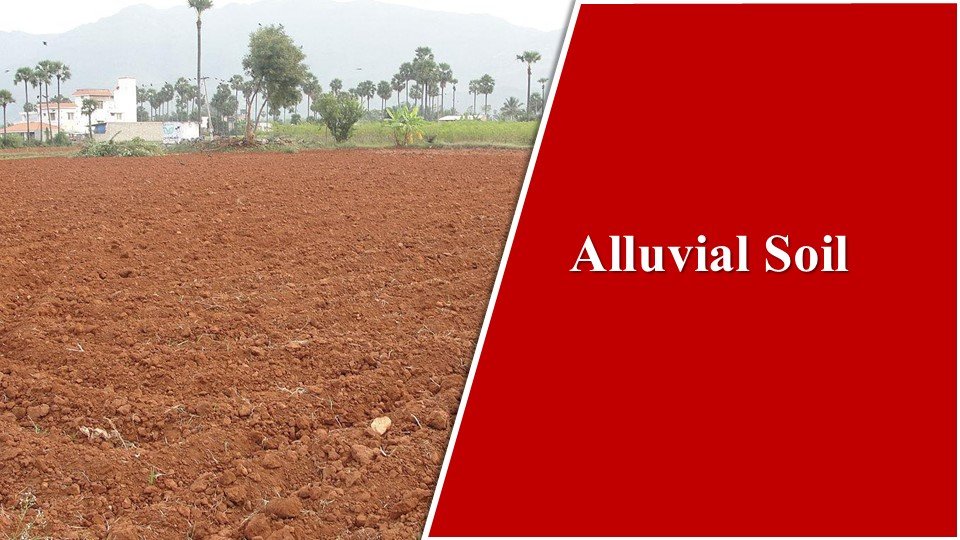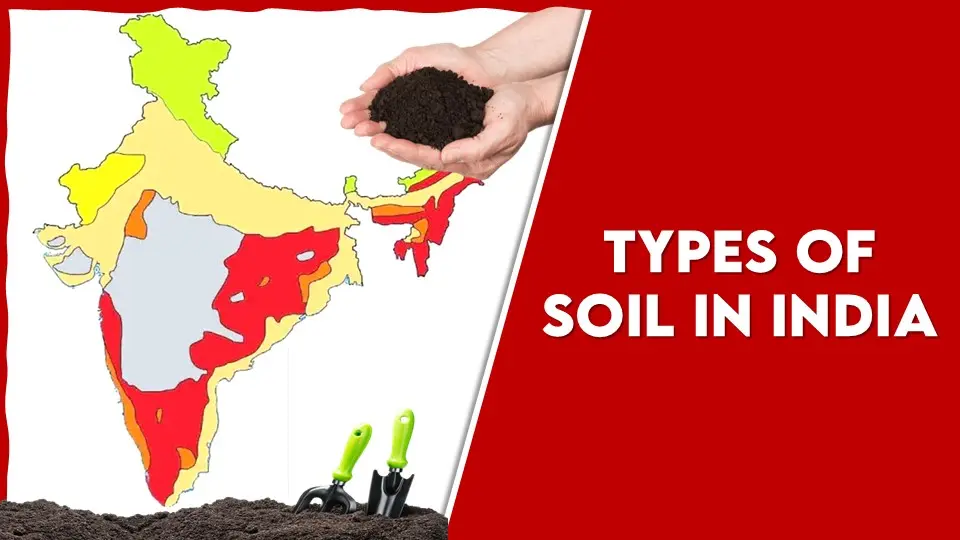The various types of soil in India show a complicated and diverse resource that is very essential to maintaining the nation’s agricultural output and fostering diverse ecosystems. This is the result of complex interactions that have occurred between the climate of the particular region, vegetation, geological processes, and human intervention over the past many years. Due to this extensive size and diverse geography, India has an expanded range of soil types, each with unique characteristics and capacities.
in India, various soil types are present, which are distinguished by attributes such as color, texture, structure, composition, and depth. Alluvial, Black, Red, Laterite, Arid, Desert, and Mountain soils are among some of the main varieties of soil prevalent in India.
Certain types of soil are required for particular crops, and effective farming techniques are essential for maintaining the health of the soil and increasing yield. the broad soil types that are found in India maintain a range of ecosystems, which in turn affect the country’s flora and fauna. These soils help to maintain the flow of water along with the recharge of groundwater plus also reduce the negative effects of flooding. Soil conservation and sustainable land management techniques are very important which helps to reduce erosion of soil, deterioration, and desertification of land.
Types of Soil in India
Vasily Dokuchaev established the first classification of soil in research. Soils in India have been classified into 8 groups by the Indian Council of Agricultural Research (ICAR). The following are the different types of soil in India:
- Alluvial soils
- Black soils (Regur Soils)
- Red soils
- Laterite and Lateritic soils
- Desert (Arid) soils
- Mountain soils
- Salt Affected soils
- Peat & Marshy soils.
1. Alluvial Soil
Fine rock fragments carried in suspension and subsequently deposited in the river’s bed and bank are referred to as alluvium. The main reason for alluvial soil formation is the silt that the Indo-Gangetic and Brahmaputra rivers contribute. Wave action develops different alluvial deposits in coastal regions. The primary material is made up of rocks that originate in the Himalayas.
As a result, these soils’ source material was relocated. With a total area of almost 15 lakh sq kilometers or 46% of the total, they are the most widespread soil group. Since they offer the most productive agricultural lands, they serve as employment for approximately 40 percent of India’s population.
- Owing to their recent development, they have weak profiles and are immature.
- The soil is mainly sandy, though clayey soils are also common.
- They vary from clayey loam near the delta to sandy- loamy in areas with less rainfall.
- Due to its loamy (equal amounts of sand and clay) arrangement, the soil is porous.
- The Khadar and Bhangar alluvial soil types are two separate kinds that have emerged in the Upper and Middle Ganga plains.
- Khadar, the new alluvium, is found in the river flood plains. Every year, fresh deposits of silt enhance Khadar.
- The old alluvium, known as bhangar, was deposited away from the flood plains.
- Impure calcium carbonate has concretion (kankars) in the soils of both Khadar and Bhangar.
- In the Brahmaputra valley and the lower and middle Ganga plains, these soils are more damp and clayey.
- The most common crops grown on alluvial soils are wheat, maize, sugarcane, legumes, oilseeds, etc.

2. Black/Regur Soils
When the basaltic rocks weather and emerge from their fissure eruptions all through the Cretaceous period, black soil is the outcome.The vast majority of black soil originates from volcanic rocks that formed in the Deccan Plateau, particularly the Rajmahal trap and the Deccan. Gneisses and schists constitute the parent material in Tamil Nadu. While the latter are often shallow, the former are appropriately deep.
This is the region with high temperatures and little precipitation. As a consequence, this soil category is typical of the hot, arid regions of the Peninsula. These rocks covers 15% of the entire area. Basalt holds titani-ferrous magnetic compounds, which are responsible for the black color.
- Black soils in uplands usually have poor fertility, whereas valley soils have high fertility.
- Moisture is highly held in the black soil. It swells significantly as moisture builds up. Dealing on such soil during the rainy season requires a lot of effort because it becomes very sticky.
- Summertime causes the soil to shrink and create wide, deep fissures as the moisture evaporates. Moisture can still be trapped in the bottom layers. The soil has excellent fertility and can be sufficiently oxygenated thanks to the cracks.

3. Red Soils
The second-biggest area of the nation is covered by this soil, which originated on Archean granite. Soil becomes red due to the presence of ferric oxides, which appear as thin coatings on soil particles. The horizon underneath is yellowish, and the top layer of soil is red in color.
Area covered: 18.5% of the total area and texture is Loamy to sandy to clayey. The omnibus group is a different term for this soil.
- The amount of rain varies significantly. As a consequence, the soil has formed into three different types.
- Red and yellow soil; 200 cm of rainfall; northeast India: Rapid drainage is required in Nagaland, Mizoram, the Manipur Hills, and some areas of the Malabar coast.
- Red sandy soil: In drier plateaus such as Telangana, TN, Karnataka, and Rayalseema have Rainfall between 40 and 60 centimeters
- Red alluvial soil, which is found in river valleys, is productive.
- The soil has a good drainage capacity and exhibits a sandy structure
- Abundant of potash and iron, but deficient in other minerals ( Phosphate, Lime, Magnesium, Nitrogen).

4. Laterite Soils
In areas where the following criteria are fulfilled, this soil has emerged. The existence of laterite rock or structure is needed (laterites contain elevated levels of iron and aluminum). These are mainly found in eastern and western ghats of the country which includes southern parts of Maharashtra, Karnataka, Andhra Pradesh, West Bengal, Odisha and Jharkhand.
The creation of laterite soils is best suited to periods of alternate dry and wet weather.
- This soil is brown.
- It is composed essentially of a mixture of hydrated oxides of aluminium and iron. Iron oxides are found in nodules form.
- It is rich in iron and aluminium but poor in Nitrogen, Phosphorous, Potash, Lime, and Magnesia.
- Its humus and water-retaining capacities are moderate.
- Bacterial activities have been very high and heavy precipitation builds leaching of humus which leads to low humus content.

5. Desert Soils (Arid Soil)
The majority of desert soil is located in dry and semi-arid areas. The major areas include southern Punjab, Rajasthan, the western regions of Haryana, Saurashtra, Kachchh, and the northern portion of Gujarat.
There is inadequate moisture in this soil. It has little organic matter, low humus, and fewer live microbes.
- It has a high lime content and nearly enough phosphorus, but rich in iron. Its capacity to hold onto moisture is limited, and it has minimal salt solubility.
- Desert soil can produce high agricultural yields if properly irrigated. It works well with less water-demanding crops such as guar, fodder, legumes, and bajra.
- The Rann of Kachchh, in western Rajasthan, is native to desert soil. Patches of this soil is also found in southern Punjab and southern Haryana.

6. Mountain Soils/ Forest Soil
The texture of these soils varies with elevation and precipitation in forested mountainous places. The texture of this type is coarse-grained, loamy, or silty, and variables like vegetation cover and height can affect fertility status.
- Plant debris like leaves, twigs, and fallen trees constantly accumulate and decompose, due to which forest soil is rich in organic matter.
- The dark brown to black appearance is a result of its high humus concentration.
- Texture: Variations in parent material, climate, and vegetation can be observed in the texture of forest soil. It has an appropriate balance of silt and clay particles and can range from sandy loam to clayey loam.
- The structure and water-holding capacity of the soil is improved by the amount of organic matter.

7. Salt Affected Soils
Saline soils are present all over the country but to be specific, are more prevalent in the northwestern and western areas, which include states like Gujarat, Rajasthan, and parts of Punjab, Haryana, and Uttar Pradesh.
- Due to the impact of seawater, these types of soil in India are majorily present in coastal locations like parts of Gujarat, Maharashtra, and Andhra Pradesh
- Salinity levels: High salt concentrations in saline soils, especially those with sodium chloride (common salt), make the soil unfit for most types of crops.
- Inadequate drainage, excessive irrigation with poor-quality water, high evaporation rates, and natural salt deposits are among the primary causes of salinity in Indian soil.
- Salinity is sometimes increased by the intrusion of seawater in coastal regions.

8. Peat and Marshy Soils
These types of soil in India have been originated from areas of wetlands with poor drainage. Although these soils are deficient in phosphorus and potash, they are rich in soluble salts and decaying matter due to their high content of organic matter. Since pineapples and rice can withstand acidity, they are grown there in certain regions.
This kind of soil covers more parts of Kerala, a region with high humidity and frequent rains. Hence the locals call this soil “Kari” once it has been mixed with soluble salts.
- It is widely recognized that the marsh soil contains a large amount of vegetative matter. This bulky, dark-colored soil has a high acidity level.
- In regions with high water tables, like the backwaters of Kerala and portions of northeastern India, peaty and marshy soils are common. Although they have a lot of organic material, still they are acidic.
- These soils are best suited to grow rice and aquatic crops and are well suited for wetland agriculture.

Inference
The above article relates with the eight major types of soil that are prevalent in India. Our country has a wide array of soil types, each with unique physical and chemical properties that determine which crops to cultivate into it.
Hence, understanding the different types of soil in India and how well it is prompt to different crops is important for the nation’s agricultural growth and economy. Through appropriate crop selection for particular soil types, farmers might maximize yields and increase the agricultural sector’s total revenue in India.
Latest Post
- Punjab & Sind Bank Introduces Special Program to Support Food and Agro-Processing Sector
- Beyond Classrooms and Gardens: How a Professor Turned His Passion into Purpose
- October Issue 2025- Times of Agriculture Magazine
- Top 10 Pesticide Companies in the World
- September Issue 2025- Times of Agriculture Magazine
- Top 15 Fertilizer Companies in the World
- Top 10 Vegetable Farming Profit Per Acre in India
- August 2025 : Times of Agriculture Magazine (AgriVoltaics Farming)
- Button Mushroom Farming: Infrastructure, Cultivation, and Profitability











